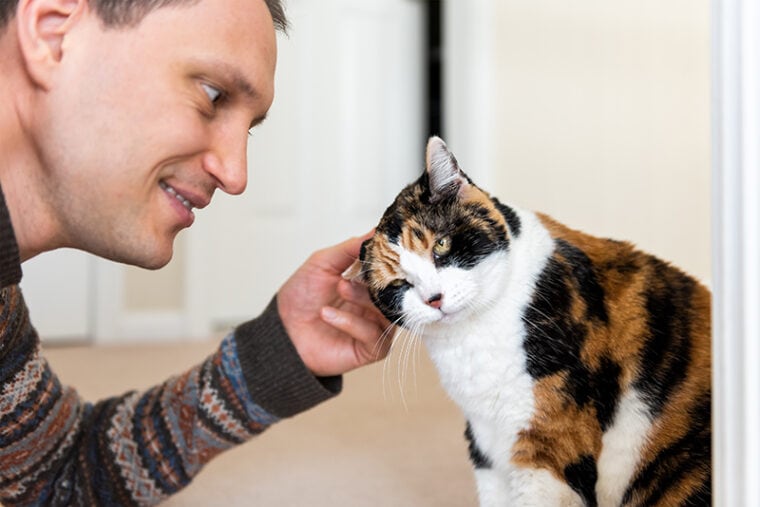
If you are thinking of adopting a deaf cat or have just learned that your cat has recently suffered from hearing loss, you might wonder how you can be the best pet parent you possibly can be. If this is your first experience owning a pet with a disability, you might be feeling overwhelmed by different information, opinions, and suggestions. To help you feel prepared, here are some vet approved facts about sharing your home with a hearing impaired feline.
The 6 Tips for Living with a Deaf Cat
1. Adjust How You Communicate
Just because your cat can’t hear your voice, doesn’t mean you can’t communicate with them. Cats respond to hand signals, lights, and laser pointers, and once they learn that you’re communicating visually, they will actually look for it. Deaf cats will also rely on other senses like smell and touch, and can sense vibrations across surfaces, so if you need to get their attention, banging on the floor or a cupboard can often draw their focus.

2. Approach With Care
There’s a saying about people who “sleep like the dead”; perhaps it should be changed to “sleep like the deaf”. If there’s one benefit to hearing loss, it’s uninterrupted sleep, but it also means that your deaf cat may startle easily, and lash out uncharacteristically. If you need to wake your slumbering kitty, be sure to use vibration or move an item near them to warn them of your approach. Giving your cat a warning will prevent you from being nipped or scratched by a startled cat that wasn’t expecting you.
3. Keep Your Cat Indoors
Unfortunately, the outside world is not safe for a deaf kitty; there are too many threats outside that could harm them. They can’t detect car horns, people shouting, or dogs barking. However, you can set up a comfortable window seat, or build a catio or cat enclosure for them to safely enjoy the outside world.

4. Add an ID Tag to Their Collar
In case your kitty ever escapes, a tag on their collar that reads “I am deaf” alongside your contact information might be useful in getting your cat back to you as soon as possible.
5. Maintain a Routine
Cats thrive on routine, but if your cat is deaf, it will be even more crucial. You can’t call your cat down for dinner, but if they know they are fed as soon as you’re home from work, they’ll anticipate it happening when you walk through the front door. Be consistent, and your cat will be comforted by knowing their needs are met.

6. Ensure You Can Locate Them
A “pet locator” like a “key finder” or a bell attached to their collar will allow you to locate them around your house. A locator might also work if they slip out of the house and aren’t too far away, depending on the range it offers.
FAQs of Living with a Deaf Cat
How Do You Find Out Your Cat Is Deaf?
It can be tricky to determine if a cat is deaf, especially if you have another cat with perfect hearing. Cats will look to another pet for visual clues about what is happening, so if you haven’t noticed that your cat is suffering from hearing loss right away, don’t feel guilty since it isn’t always obvious.
Some subtle signs of deafness include heavy sleeping and startling easily. If your cat seems unobservant and consistently doesn’t notice when you enter the room, they are probably deaf. A simple test you can use is to make a loud noise when your cat isn’t looking at you; you could rattle your keys or clap your hands. Try different types of sounds; high pitched whistling to deep low rumbling, as some cats will be able to hear some frequencies and not others.
Another potential indicator of deafness is their meow. Cats born deaf, or deaf from a very young age will often not meow, having never heard others do it, or be using it to respond to us. Cats that are becoming or have become deaf will often start meowing more loudly, sometimes a wailing cry, as they adjust to being unable to hear themselves.

Why Is My Cat Deaf?
There are three main types of deafness in felines:
1. Congenital sensorineural deafness
These cats are either born deaf or become deaf within their first weeks of life, due to a genetic defect that affects cochlear cells. This defect is found almost exclusively in cats with white fur and blue eyes, and will occur within the first few weeks of the cat’s life. Not all white-furred, blue-eyed cats will be deaf, and white cats with just one blue eye do not appear to be affected either.
2. Acquired sensorineural deafness
This describes deafness due to irreversible damage to the cochlear nerves, and may result from:

3. Conductive deafness
This is due to a physical obstruction that is stopping soundwaves from reaching the inner ear. Things like wax, infection, ear polyps or a ruptured eardrum can cause conductive deafness. Fortunately, this form of deafness can often be resolved if the obstruction is removed.
Conclusion
Cats have extraordinary hearing, but when they’re deaf, they need more assistance from their owners. Although their routine will change, deaf cats can live happy lives when they’re cared for properly. By keeping them safely indoors, establishing a new form of communication with hand signals, and alerting them before you touch them, you can help your cat navigate their new reality and keep them safe.
Featured Image Credit: Kristi Blokhin, Shutterstock








